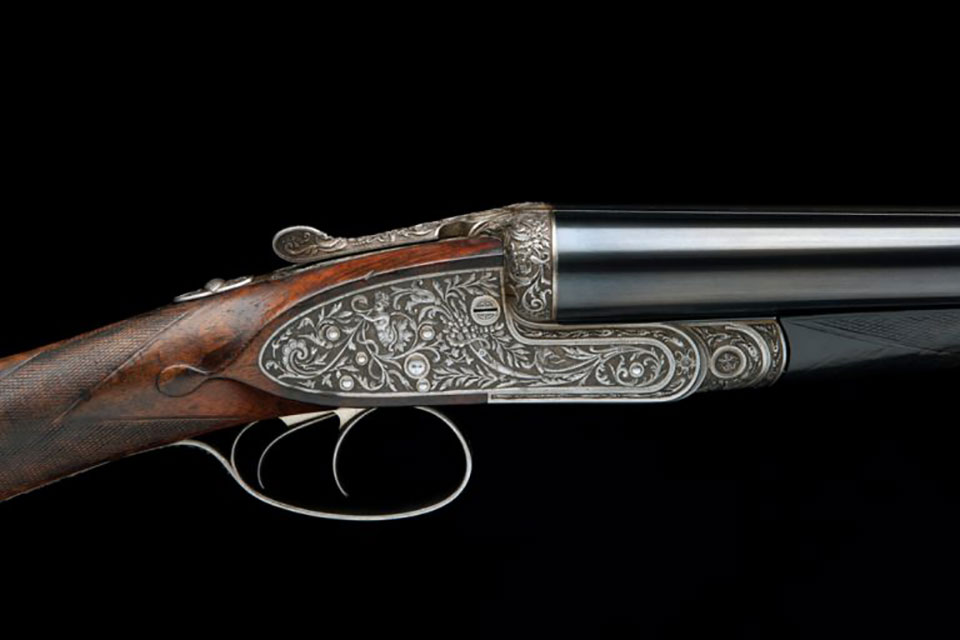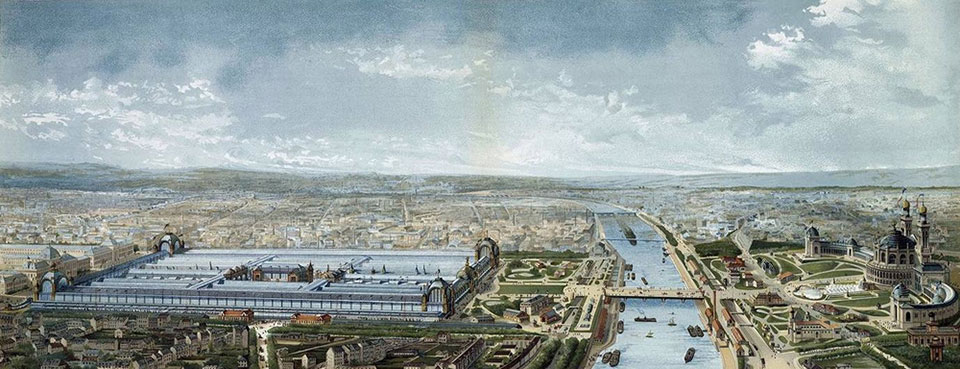Over the second half of the nineteenth century, fourteen international exhibitions were held around the world, starting in London with the ‘Great Exhibition’ of 1851.
These were organised to coincide with particularly notable celebrations or commemorations in the host country, and featured displays of both technological innovation and artisanal skill that were perfectly suited to showing off the gun maker’s art.
James Purdey did not exhibit in 1851, but the firm attended at least five subsequent exhibitions, winning medals in Philadelphia (1876), Paris (1878), Melbourne (1880-1) and Calcutta (1883-4), which were then referenced in the company’s marketing.
Unfortunately, lists of the exhibits taken only survive for two of these shows, but both are remarkably detailed, including the guns taken and the ancillaries as well. The earlier of these lists relates to the Parisian Exposition Universelle, held between 1 May and 10 November 1878. Coincidentally, this appears to be the only occasion where a contemporary description of the display exists, and the combination of the two provides a fascinating snapshot of a key moment in the company’s history.
some of the guns taken were completed as early as 1872
On 1 January 1878, James Purdey the Younger marked twenty years since he had purchased the company from his father. In turn, his two eldest sons had joined the business, and under a Deed of Agreement signed by all three men on 21 December 1877, he had formally changed the company’s name to ‘James Purdey & Sons’, just in time for the Exposition Universelle. It is not clear from the records how long Purdey had been preparing for this exhibition, but some of the guns taken were completed as early as 1872, suggesting that they may even have gone to the Centennial Exposition in Philadelphia, held in 1876.
From surviving records, the Purdey display in Paris appears to have been the largest of any exhibition by the firm in the Victorian period. The majority of the display items were sent over on 18 April, about two weeks before the exhibition opened. This included twenty-nine guns, framed pictures, warrants, and all of the cleaning and maintenance accessories needed for the show.

Three more guns were sent on 26 April, meaning that thirty-two guns were displayed on Purdey’s stand when the show opened. This included the four ‘Chased’ examples that secured the firm its gold medal. Nine further guns were sent to the exhibition over the next few months, with the final two arriving on 1 October. Whether these were filling gaps left by guns having been sold, or just guns being delivered at the show, is not entirely clear.
Purdey’s stand was described in some detail by the journalist George Augustus Sala, in his book, Paris Herself Again in 1878-9:
'There is a glass case belonging to a Gold Medallist which it would be decidedly unjust to pass without mention ere the Exposition Universelle comes to the end of its wondrous career. I allude to one containing the sporting guns and rifles manufactured by Messrs. James Purdey & Sons of Oxford Street, London.'
elaborately chased in the champ-levé style, two of which have been embellished by the talented artist Aristido Barri,
Most of the fowling-pieces and rifles, complete in workmanship and exquisite in finish, exhibited by Messrs. Purdey, who are gun-makers to the Queen and the Prince of Wales, have been purchased by Royal and noble personages, including the Prince de Croy, who has secured no less than five of these fine weapons, the Prince Imperial of Austria, Prince Mavrocordato, Prince Boris-Czetwertynski, the Duke de Castries, Baron Albert de Rothschild, M. Patrice de MacMahon, and last, though not least, Prince Arthur of Saxe Coburg Gotha. One side of the Purdey glass case is decorated with photographs of sporting trophies of the game shot on various excursions in Europe by the Prince of Wales, the Emperor of Russia, and the late King of Italy.
There is also the reproduction of a trophy of African antelopes, shot by two adventurous English sportsmen, J.L. Garden, Esq., and Captain Garden. The well-known and indeed leading speciality of the Purdey guns is extreme lightness, obtained without any sacrifice of strength. Another is the new system introduced by Messrs. Purdey of boring for ‘small charges,’ so that longer range and better results may be obtained than can be procured by the old system of heavy guns with large charges. The light guns are altogether free from ‘kick’ or recoil.
The extra Purdey exhibit consists of four guns, elaborately chased in the champ-levé style, two of which have been embellished by the talented artist Aristido Barri, who was arrested at Vienna as a Communist, but was subsequently released, and is now occupied in executing a champ-levé for the Emperor of Austria. There is likewise a pair of very handsome guns, with stocks of ornamental maple, having the appearance of tortoiseshell, and the steel portions of which are exquisitely inlaid in gold.
A pair of beautiful guns for ladies’ use must also claim a word. The stocks of these guns are ebonised, and the weapons themselves are of extreme lightness: still I am told that a distinguished pigeon shot at a recent Monaco competition succeeded in killing with one of them fifteen out of eighteen birds at twenty-eight yards’ rise. The crack shots of Hurlingham and Shepherd’s Bush are in the habit of favouring with their presence the competitions organised by the brothers Dennetier, in the diminished strip of territory belonging to Prince Charles of Monaco, to the sore discomfiture of their Continental rivals.
a distinguished pigeon shot at a recent Monaco competition succeeded in killing, with one of them, fifteen out of eighteen birds
On these occasions the death-dealing barrels of Mr. Dudley Ward, Sir R. Musgrave, Earl de Grey, and Captain Vansittart give plenty of employment to Nelly, the famous bitch upon whom devolves the onerous task of retrieving the slaughtered pigeons, which frequently average six hundred per diem.
Especially interesting in the Purdey exhibit is an extremely ingenious mechanical gun, which, by means of an arrangement of screws, can be twisted and turned into any shape, and fixed there for measurements to be taken from it, so that the gun to be manufactured can be suited to ‘the mount’ of any particular sportsman who is in the habit of shooting from the right or left eye, or from the right or the left shoulder, respectively. I am informed that no less than 7000l. in money prizes alone, exclusive of cups, have been won by noblemen and gentlemen using Purdey guns at Hurlingham and the Gun Club last year.

This gives an idea of both Purdey’s clientele of the time and the grandeur of the display itself. Sala’s description of the stand also provides further details, particularly of the subject of the eleven pictures displayed alongside copies of both Royal Warrants. Queen Victoria had only presented her warrant on 29 March, just under three weeks before it was shipped to Paris, demonstrating how keen the company was to capitalise on it. It also explains why the company’s archive includes duplicate copies of these original warrants.
The family’s representative at the exhibition was James the Younger’s eldest son, James III. James Junior was born in 1854 and in the 1871 Census, at age sixteen, was described as ‘Assistant at father’s trade’. It appears that he was not apprenticed as a stocker, but was instead being given a more general grounding in both the gunmaking and sales aspects of the business, in preparation to succeed his father.
He was already undertaking business trips to Paris on his own in 1876, at the age of just twenty-two, and so would have been familiar with many of the clients he would encounter at the Exhibition. ‘Mr. James’ Tools’ were included with the first shipment in April, amongst which may have been the ‘Measuring Gun’ referred to in Sala’s description. This was patented by his father in 1873, and an example is still displayed at Audley House today.
In Purdey: The Guns and the Family, Richard Beaumont suggests that the exhibition was not a commercial success, but this appears to be based on a misunderstanding of the records. Seventeen guns were sold, all at full price, rather than the twelve he describes as being sold ‘with a discount of 10%.’
This was perhaps James Junior’s greatest impact on the company...
Most of the remaining guns and rifles were sold over the course of the following two years, and without particularly heavy discounts. Beaumont’s assessment also dismisses the wider sales opportunities associated with the exhibition. At least two of the firearms displayed in Paris are referenced by James Junior in his order notebooks, and four were exhibited at Sydney in 1879, alongside the medal won in Paris. As such, the company were able to generate other orders from them while they were still in hand.

In retrospect, the Exposition Universelle of 1878 was a landmark event for the company. It was the first event where it appeared as “James Purdey & Sons”, and as Gunmakers to Queen Victoria. The number and quality of the arms displayed at Paris means that they remain the subject of fascination today, and the gold medal formed part of the company’s marketing until at least the mid-1880s.
This was perhaps James Junior’s greatest impact on the company, as his health was always fragile and he eventually contracted tuberculosis. This meant that he could no longer work in the business, travelling to South Africa in the hopes that this would improve his health.
Sadly, he succumbed to the disease in 1890, aged just thirty-six. James the Younger was eventually succeeded by his second son, Athol, who went on to lead the company into the twentieth century.
Dr. Nicholas Harlow is Gunroom Manager at James Purdey & Sons in London.
Published by Vintage Guns Ltd on (modified )




